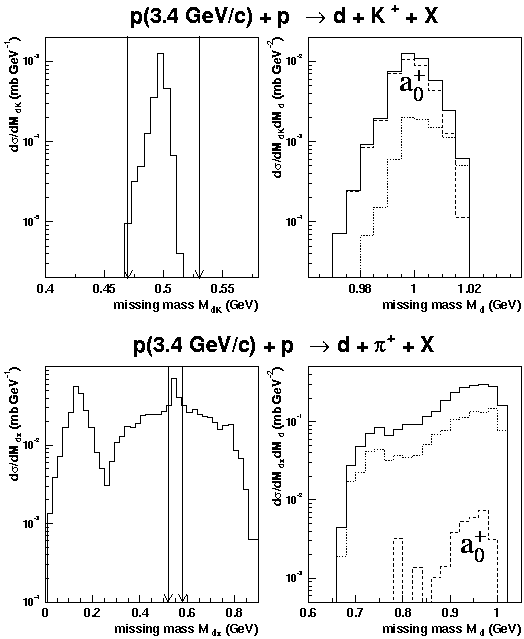|
The structure of the lightest scalar mesons a0(980) and f0(980) is
not well understood (see the ``note on scalar mesons'' of the particle
data group [1]). In a recent paper [2] the necessity of new
measurements of a0 production and of a0 branching ratios for
clarifying the a0 structure has been emphasized. Such an experiment
is presently prepared at COSY [3].

Fig. 1
Missing mass distributions for the reactions pp ® d K+X
(upper panels) and pp ® d p+X (lower panels) calculated at
incidence momentum 3.4 GeV/c for polar angles Q £ 10° and 1.5% momentum resolution. The two arrows in the left
hand panels indicate the windows in the MdK and Mdp
distributions, which are used in the calculation of the Md
distribution shown in the right hand panels. The dashed histograms
indicate the contributions from the reaction pp ® da0+, the
dotted histograms those of the nonresonant channels pp ® dK+[`(K0)] and pp ® dp+h, respectively.
Although in Ref. [2] predictions for the reaction pp® da0+ at COSY
energies have been given, no attempt has been made to compare the
channels with a0+ production and subsequent decays, pp® da0+® dK+[`(K0)] and pp® da0+ ® dp+h, with the
nonresonant channels pp ® dK+[`(K0)] and pp ® dp+h.
For the measurement of a0+ production the latter channels might be
rather disturbing if they are of high intensity. Another source of
background are multipion channels, where two or three pions may have an
invariant mass similar to the h mass. In Fig. 1 ROC model [4]
predictions of the cross sections for a0+ production together
with an estimate of the cross sections for the nonresonant and the
multipion channels at the highest COSY energy are given. In these
calculations the a0+ is considered as a usual quark model state with
two decay channels a0+ ® K+[`(K0)] and a0+ ® p+ h.
The missing mass distributions of two particles are used to select the
mass of the third particle defining thus the final channel. Then the
signal from the a0+ is looked for in the missing mass distribution
of the d. In case of strangeness production there are no background
reactions, while channels with three or four pions may contribute to the
h window in the Mdp distribution. The difference between
the full and the dotted histogram in the lower right panel of Fig. 1 is
the contribution from these pion channels.
The main difficulty consists in differentiating between the channels via
the a0+ meson and the channels with nonresonant production,
especially in case of the channel pp ® dK+[`(K0)], where the
missing mass Md varies only by about half the assumed width of the
a0+ meson. The value of the calculated cross section for a0+
production is closely related to the assumption that the a0+
consists of light quarks. For the direct population of the channel
pp® dK+[`(K0)] the creation of a d[`d] and a s[`s] pair
is necessary. Strange quark production is suppressed and, therefore, the
larger contribution to the final channel dK+[`(K0)] comes from an
intermediate a0+. In case of the decay channel, a0+ ®p+h, the ROC model predicts higher cross sections for the
nonresonant channel than for a0+ production. Therefore, the
measurements should be carried out with high statistics.
References
[1] C. Caso et al., Eur. Phys. J. C 3 (1998) 1
[2] V. Y. Grishina et al., Eur. Phys. J. A 9 (2000) 2, 277,
nucl-th/0007074
[3] V. Chernyshev et al., COSY Proposal #55:
Study of a0+ mesons at ANKE (1997), cf.
http://ikpd15.ikp.kfa-juelich.de:8085/doc/Anke.html
[4] H. Müller, Eur. Phys. J. C 18 (2001) 563,
hep-ph/0011350
IKH
05/31/01
© H. Müller
|
